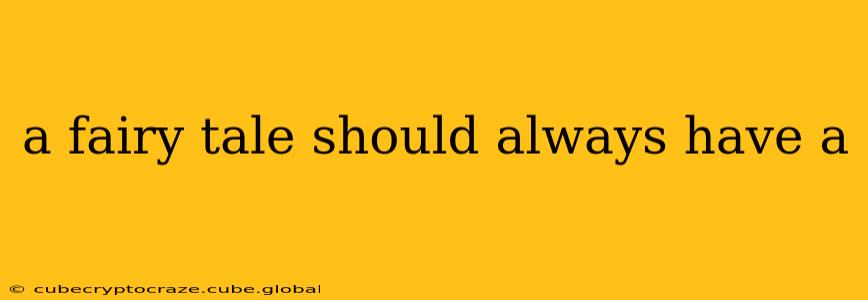A Fairy Tale Should Always Have a...Happy Ending? Rethinking the Classics
The classic notion of a fairy tale often conjures images of princesses, princes, happily-ever-afters, and perhaps a talking animal or two. But what truly defines a fairy tale? Is it simply a happy ending? Or is there more to the magic than meets the eye? Let's delve into the essential elements and explore some fascinating nuances.
While a happy ending is frequently associated with fairy tales, it's not necessarily a defining characteristic. Many classic stories, while containing elements of fantasy and magic, conclude with bittersweet outcomes or even tragedy. The real magic lies in the other ingredients.
What Makes a Fairy Tale? More Than Just a Happy Ending
1. A Moral or Lesson: This is arguably the most critical component. Fairy tales often serve as cautionary tales, teaching valuable life lessons about kindness, courage, honesty, and the consequences of bad choices. Whether the ending is happy or sad, the takeaway should resonate with the reader long after the story concludes. Think of the persistent message of perseverance in "The Little Engine That Could" or the importance of inner beauty highlighted in "Beauty and the Beast."
2. Magical or Fantastical Elements: This is the obvious ingredient! Dragons, fairies, witches, talking animals, and magical transformations all contribute to the enchanting world of fairy tales. These elements provide a framework for exploring themes and lessons in a more engaging and memorable way. The magic doesn't need to be overtly fantastical; it can be subtle, woven into the narrative through metaphors and symbolism.
3. Archetypal Characters: Fairy tales often feature archetypal characters—the wicked stepmother, the brave knight, the damsel in distress. These characters represent universal themes and emotions, making the stories relatable across cultures and generations. The familiarity of these archetypes allows the reader to immediately grasp the dynamics and conflicts within the narrative.
4. A Journey or Transformation: Most fairy tales involve a journey, either physical or emotional. The protagonist often undergoes a significant transformation, learning from their experiences and overcoming obstacles. This arc, whether leading to a "happily ever after" or a more nuanced conclusion, is crucial for the story’s impact. Consider Cinderella's transformation, both literally and figuratively, or the growth and self-discovery of the main character in "The Wild Swans."
5. A Sense of Wonder and Imagination: Fairy tales should evoke a sense of wonder and stimulate the imagination. They should transport the reader to another world, allowing them to escape reality for a while and engage with the magical possibilities of storytelling. This element is perhaps the most subjective, yet essential to the overall impact and lasting appeal of the genre.
Do All Fairy Tales Need a Happy Ending?
The answer is a resounding "no." While the idea of a happy ending persists in popular culture, focusing solely on this aspect ignores the richness and complexity that many fairy tales offer. Consider these points:
-
Realistic Portrayals of Life: Some fairy tales embrace a more realistic depiction of life, acknowledging the complexities of human nature and the presence of tragedy. These stories can be just as impactful, teaching valuable lessons about resilience and coping with adversity.
-
Exploring Darker Themes: Many fairy tales explore darker themes like death, loss, and betrayal. These stories can be deeply affecting and provide readers with an opportunity to confront and process difficult emotions in a safe and metaphorical context.
-
Ambiguous Endings: Some fairy tales leave the ending open to interpretation, encouraging readers to reflect on the story's themes and draw their own conclusions. This ambiguity can add depth and intrigue, leaving a lasting impression.
In conclusion, while a happy ending might be a common trope, it's not the defining characteristic of a fairy tale. The true magic lies in the moral, the fantastical elements, the archetypal characters, the journey of transformation, and the ability to evoke a sense of wonder. The ending, whether happy or not, should serve the story and its underlying message.
